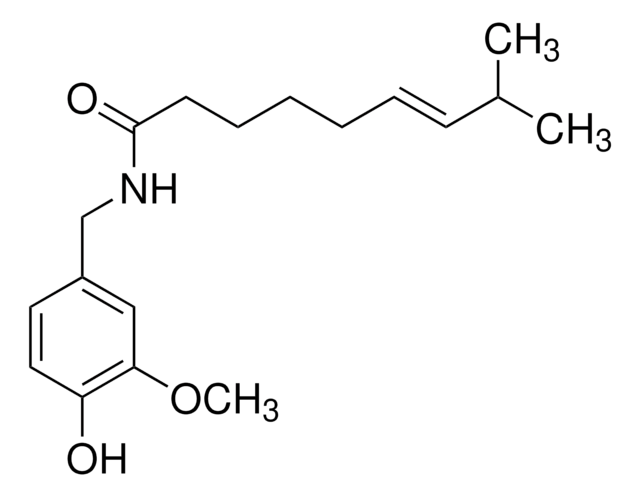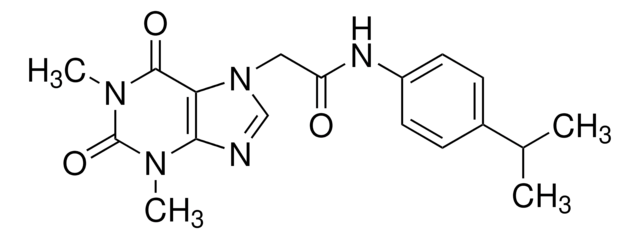M2028
Capsaicin
from Capsicum sp., ≥95% (HPLC), powder, TRPV1 agonist
Sinônimo(s):
8-Methyl-N-vanillyl-trans-6-nonenamide
About This Item
Produtos recomendados
Nome do produto
Capsaicin, ≥95%, from Capsicum sp.
fonte biológica
Capsicum sp.
Ensaio
≥95%
pf
62-65 °C (lit.)
solubilidade
H2O: insoluble
ethanol: soluble
temperatura de armazenamento
2-8°C
cadeia de caracteres SMILES
COc1cc(CNC(=O)CCCC\C=C\C(C)C)ccc1O
InChI
1S/C18H27NO3/c1-14(2)8-6-4-5-7-9-18(21)19-13-15-10-11-16(20)17(12-15)22-3/h6,8,10-12,14,20H,4-5,7,9,13H2,1-3H3,(H,19,21)/b8-6+
chave InChI
YKPUWZUDDOIDPM-SOFGYWHQSA-N
Informações sobre genes
human ... CYP1A2(1544) , TRPV1(7442)
rat ... Trpv1(83810) , Trpv4(66026)
Procurando produtos similares? Visita Guia de comparação de produtos
Descrição geral
Aplicação
- to study its effects on chromatin remodeling and gene expression related to synaptic plasticity
- to study TRPV1 channel signaling in H2C1 cells (which are human embryonic kidney 293 cells expressing TRPV1 channels)
Ações bioquímicas/fisiológicas
Palavra indicadora
Danger
Frases de perigo
Declarações de precaução
Classificações de perigo
Acute Tox. 2 Oral - Eye Dam. 1 - Resp. Sens. 1 - Skin Irrit. 2 - Skin Sens. 1 - STOT SE 3
Órgãos-alvo
Respiratory system
Código de classe de armazenamento
6.1A - Combustible acute toxic Cat. 1 and 2 / very toxic hazardous materials
Classe de risco de água (WGK)
WGK 3
Ponto de fulgor (°F)
235.4 °F - closed cup
Ponto de fulgor (°C)
113 °C - closed cup
Equipamento de proteção individual
Eyeshields, Faceshields, Gloves, type P2 (EN 143) respirator cartridges
Escolha uma das versões mais recentes:
Já possui este produto?
Encontre a documentação dos produtos que você adquiriu recentemente na biblioteca de documentos.
Nossa equipe de cientistas tem experiência em todas as áreas de pesquisa, incluindo Life Sciences, ciência de materiais, síntese química, cromatografia, química analítica e muitas outras.
Entre em contato com a assistência técnica









